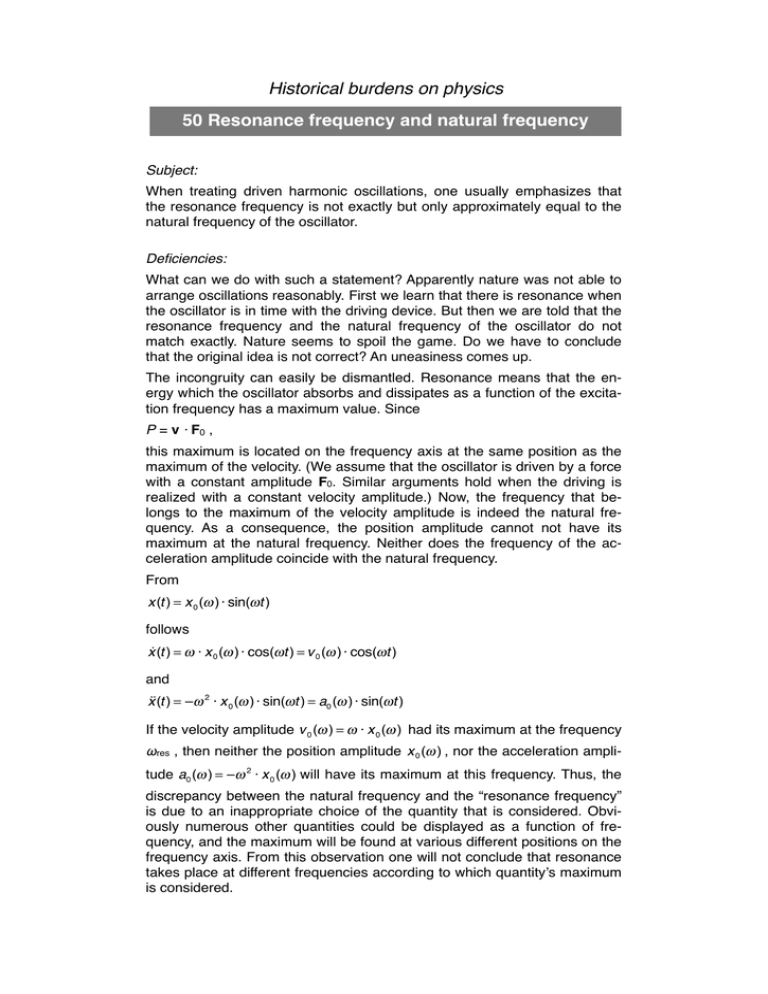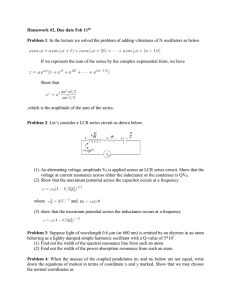50. Resonance frequency and natural frequency
advertisement

Historical burdens on physics 50 Resonance frequency and natural frequency Subject: When treating driven harmonic oscillations, one usually emphasizes that the resonance frequency is not exactly but only approximately equal to the natural frequency of the oscillator. Deficiencies: What can we do with such a statement? Apparently nature was not able to arrange oscillations reasonably. First we learn that there is resonance when the oscillator is in time with the driving device. But then we are told that the resonance frequency and the natural frequency of the oscillator do not match exactly. Nature seems to spoil the game. Do we have to conclude that the original idea is not correct? An uneasiness comes up. The incongruity can easily be dismantled. Resonance means that the energy which the oscillator absorbs and dissipates as a function of the excitation frequency has a maximum value. Since P = v · F0 , this maximum is located on the frequency axis at the same position as the maximum of the velocity. (We assume that the oscillator is driven by a force with a constant amplitude F0. Similar arguments hold when the driving is realized with a constant velocity amplitude.) Now, the frequency that belongs to the maximum of the velocity amplitude is indeed the natural frequency. As a consequence, the position amplitude cannot not have its maximum at the natural frequency. Neither does the frequency of the acceleration amplitude coincide with the natural frequency. From x(t ) = x 0 (ω ) · sin(ωt ) follows ) = ω · x 0 (ω ) · cos(ωt ) = v 0 (ω ) · cos(ωt ) x(t and ) = –ω 2 · x 0 (ω ) · sin(ωt ) = a0 (ω ) · sin(ωt ) x(t If the velocity amplitude v 0 (ω ) = ω · x 0 (ω ) had its maximum at the frequency ωres , then neither the position amplitude x 0 (ω ) , nor the acceleration amplitude a0 (ω ) = –ω 2 · x 0 (ω ) will have its maximum at this frequency. Thus, the discrepancy between the natural frequency and the “resonance frequency” is due to an inappropriate choice of the quantity that is considered. Obviously numerous other quantities could be displayed as a function of frequency, and the maximum will be found at various different positions on the frequency axis. From this observation one will not conclude that resonance takes place at different frequencies according to which quantity’s maximum is considered. Origin: Presumably our tendency to put in the foreground what we see with our eyes. We have become accustomed to regard a mechanical problem as solved when we know the trajectory of the bodies, i.e. the position as a function of time. But again and again we have to admit that in mechanics the quantities momentum and energy are more fundamental than the kinematic quantities. Disposal: Not define resonance by means of the positional amplitude, i.e. by the manifest quantity. Resonance is when the absorbed energy has its maximum value. Friedrich Herrmann, Karlsruhe Institute of Technology



